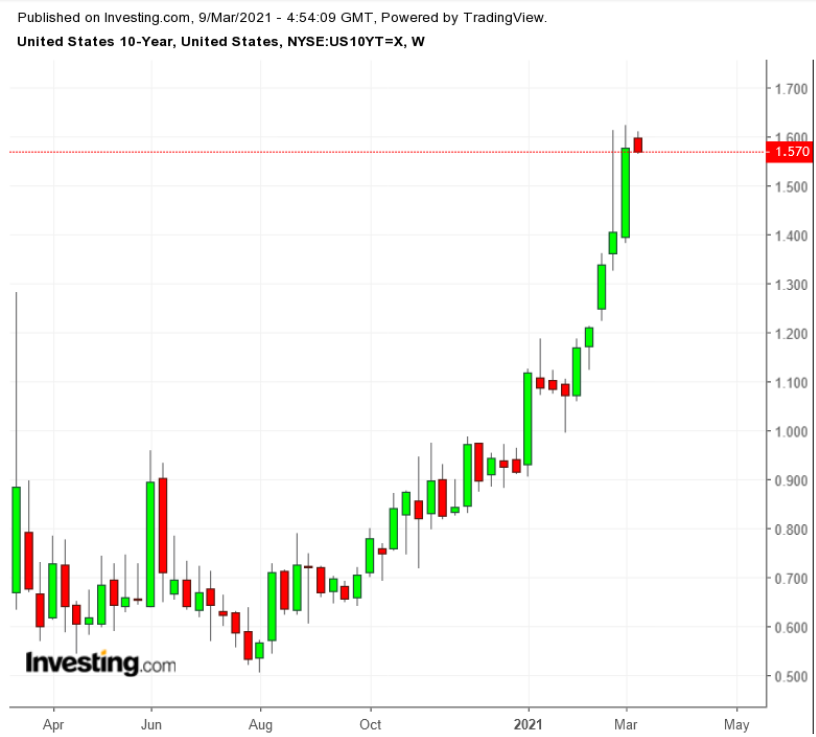Investors moved into uncharted waters as yields on 10-year Treasuries, which continued to rise, indicated some skepticism about the Federal Reserve’s insistence it will maintain monetary accommodation until there is a broad and sustained recovery in employment.

The benchmark 10-year yield hovered above 1.6% on Monday and settled there after some dips below that mark. Meanwhile, 10-year inflation expectations, derived from the yield on Treasury inflation-protected securities, kept well above 2%, nearing 2.25%.
But analysts noted that five-year inflation expectations were even higher, above 2.5%, indicating investors expect Fed intervention at some point to dampen rising prices.
Senate passage of the $1.9 trillion COVID relief package over the weekend drove investors on Monday. On the one hand, the Dow Jones Industrial Average closed up nearly 1% at 31,802 while Treasury prices declined, with the yield remaining well above the Friday close (bond prices move inversely to yields).
Declining Infections, Additional Stimulus, Pent-Up Demand
The House was expected to approve Senate changes as early as Tuesday, sending the bill to the White House for President Joseph Biden’s signature. The fillip to the economy from payments to individuals and expanded unemployment benefits along with other spending is coinciding with a marked decline in COVID infections and the prospect of reopening businesses.
No one really knows what will happen as lockdowns ease. Will pent-up demand, forced savings, and relief benefits spark a boom and will that in turn spur inflation? That seems to be the expectation, but the pace of growth and inflation is a question mark.
Will the Fed hold off raising interest rates for three years in the face of rising inflation? Maybe, maybe not.
Will rising interest rates, with or without Fed intervention, choke off economic recovery and hinder the maximum employment targeted by the Fed? Perhaps.
The Wednesday auction of $38 billion in 10-year Treasury notes will give some indication of how firm the market is after primary dealers were forced to take up a large portion of seven-year notes in a Feb. 25 auction some called brutal.
Yields on eurozone government bonds also rose on Monday, spurred by rising U.S. Treasury yields and a spike in Brent crude prices above $70 a barrel after a foiled attack on Saudi oil facilities.
The European Central Bank disclosed late Monday that it had nonetheless slowed its bond purchases under the pandemic emergency purchase program, to a net €11.9 billion in the week to Mar. 3 from €12 billion the previous week and an €18 billion weekly average, despite having nearly €1 trillion still left in its PEPP war chest. The ECB said the net purchase amount was weighed down by a high volume of redemptions, but analysts concluded central bank policymakers see little need to dampen the rise in yields.
The ECB governing council meets this week and investors will be watching for any signs that the central bank will step up the pace of its bond purchases.
Fed policymakers have been busy on their speaking circuits ahead of the quiet period this week emphasizing that employment, not inflation, is their top priority. And not just the headline figure, but an inclusive look that takes account of higher unemployment among ethnic minorities. The meeting of the Federal Open Market Committee is March 16-17.
Which stock should you buy in your very next trade?
With valuations skyrocketing in 2024, many investors are uneasy putting more money into stocks. Unsure where to invest next? Get access to our proven portfolios and discover high-potential opportunities.
In 2024 alone, ProPicks AI identified 2 stocks that surged over 150%, 4 additional stocks that leaped over 30%, and 3 more that climbed over 25%. That's an impressive track record.
With portfolios tailored for Dow stocks, S&P stocks, Tech stocks, and Mid Cap stocks, you can explore various wealth-building strategies.
